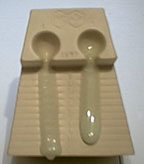Glaze chemistry works best when changing material amounts, not material types
Two glazes, same chemistry, different materials. The glaze on the left is sourcing CaO from wollastonite, the one on the right from insight-live.com/material/173">calcium carbonate. Thus the oxide chemistry of the two is the same but the recipe of materials sourcing that chemistry is different. The difference in this GLFL test for melt flow is an expression of how choosing different mineral sources to source an oxide can produce melting patterns that go outside what the chemistry suggests. The difference here is not extreme, but it can be much more. Glaze chemistry is relative, not absolute. It works best when you are changing material amounts, not material types. When you do introduce a very different mineral then you have a different system which has its own relative chemistry.
Pages that reference this post in the Digitalfire Reference Library:
Wollastonite, CaO, Glaze Chemistry

This post is one of thousands found in the Digitalfire Reference Database. Most are part of a timeline maintained by Tony Hansen. You can search that timeline on the home page of digitalfire.com.
